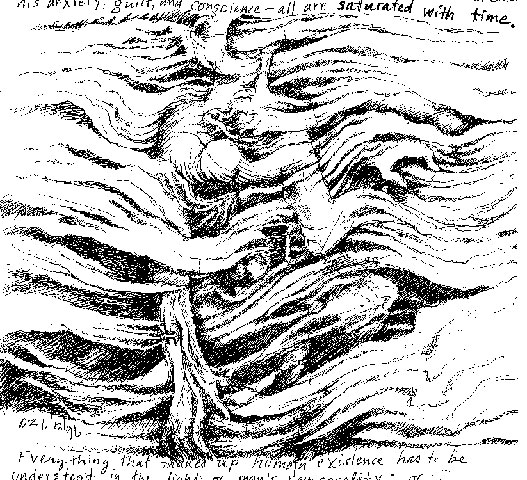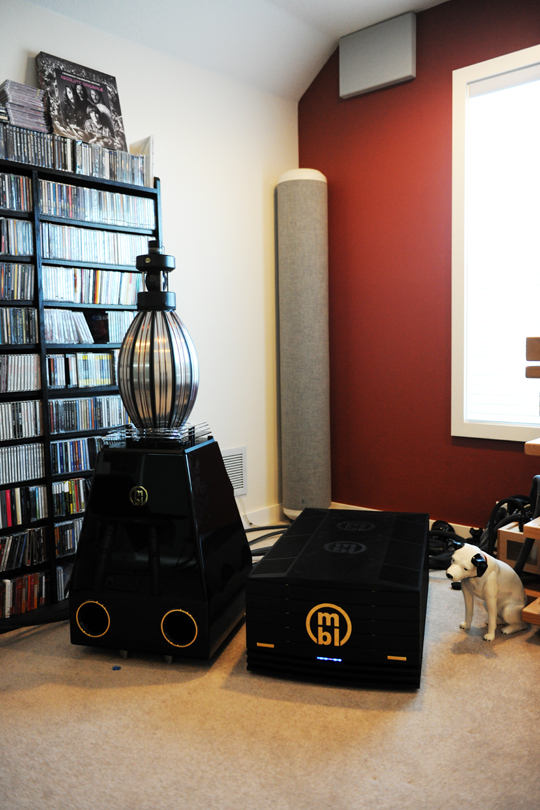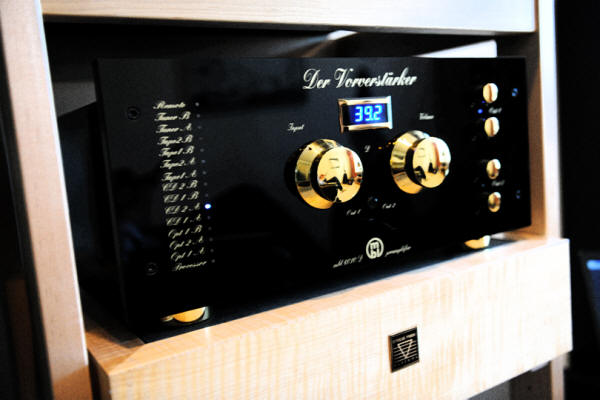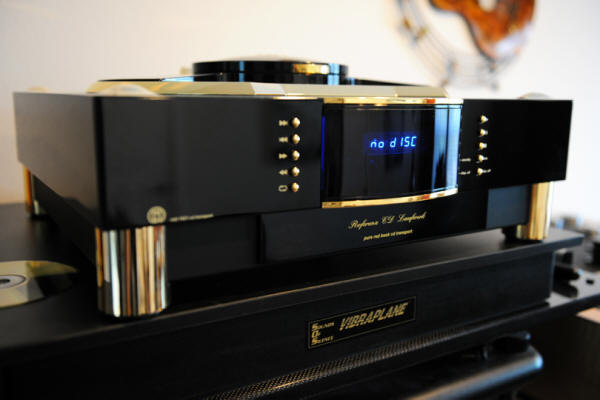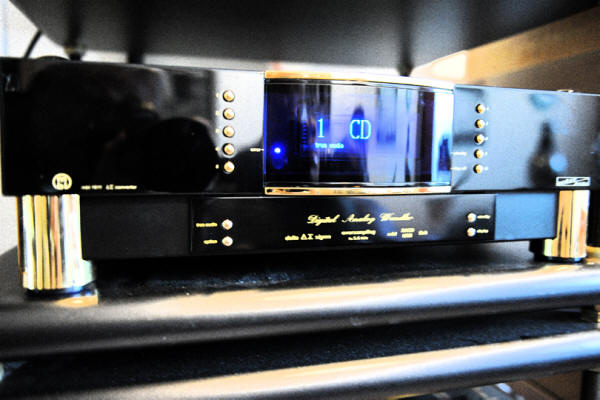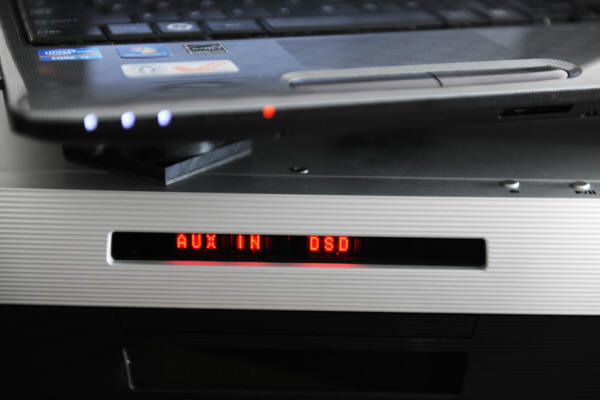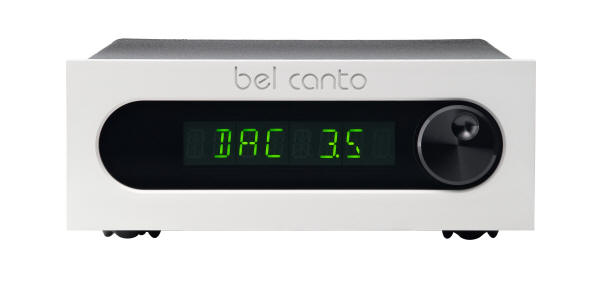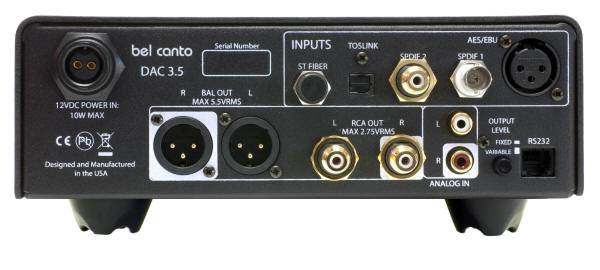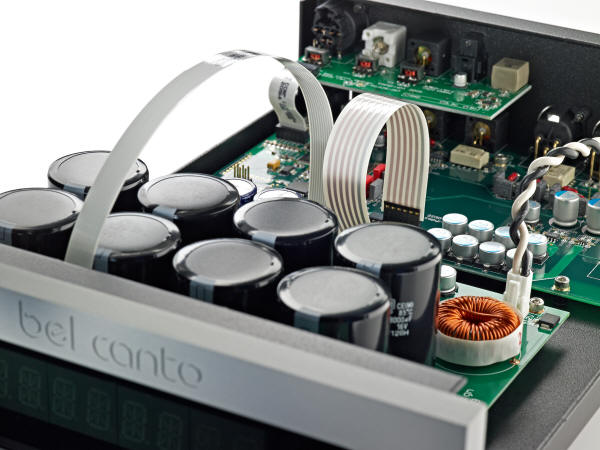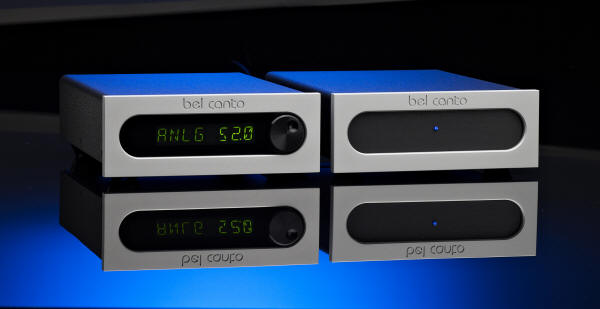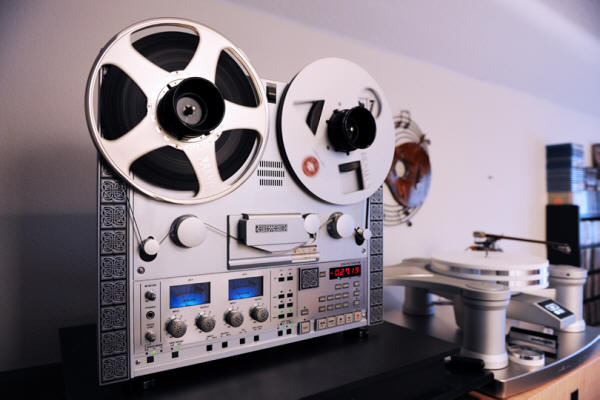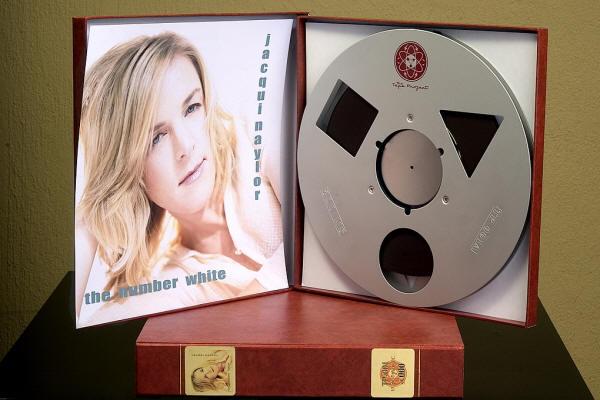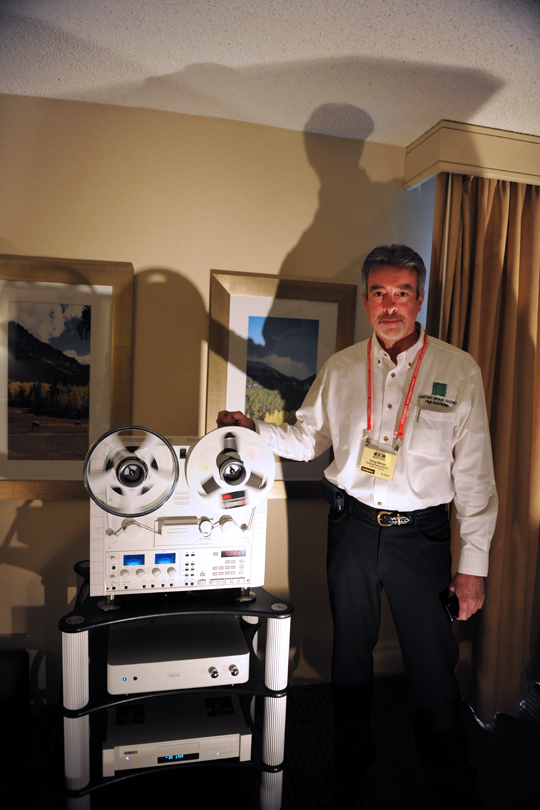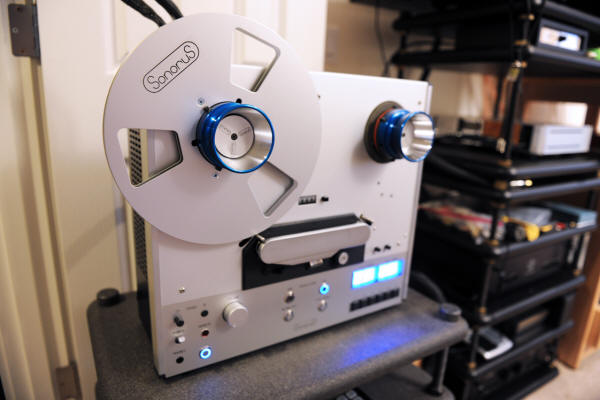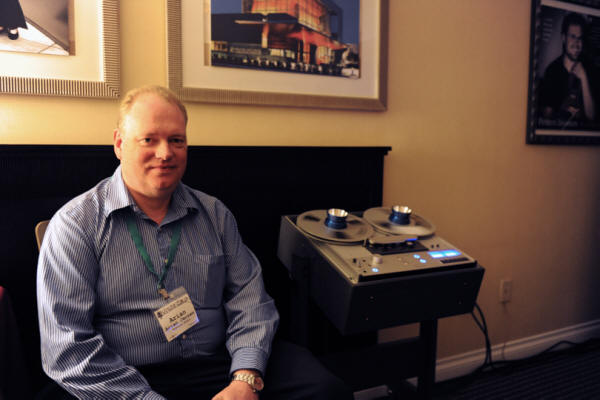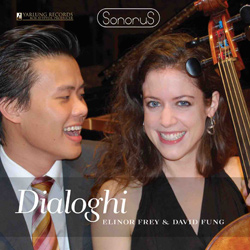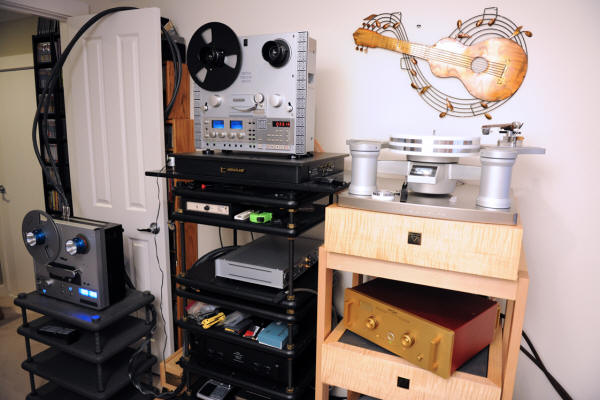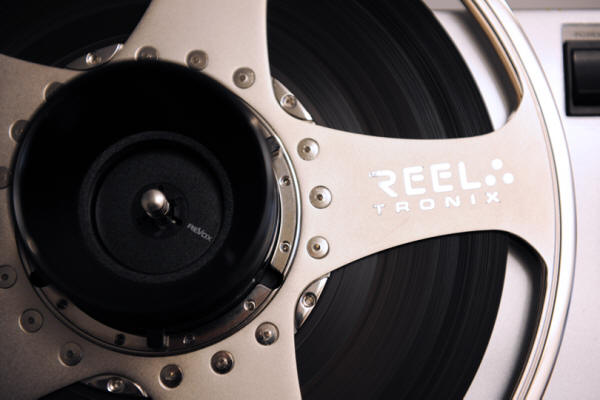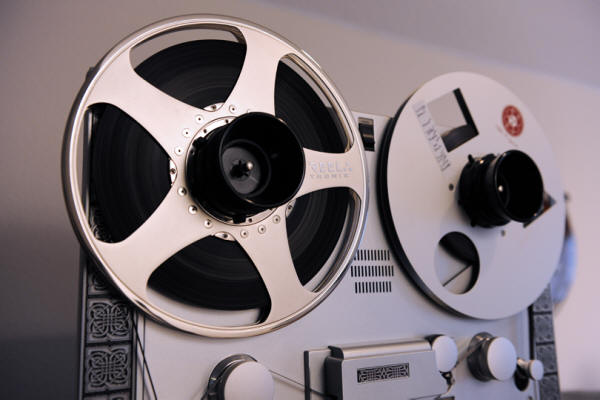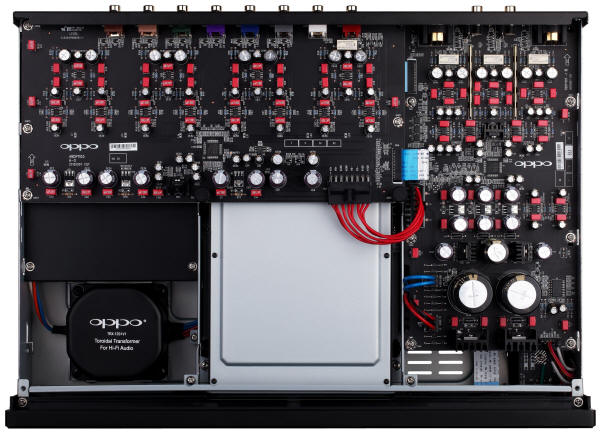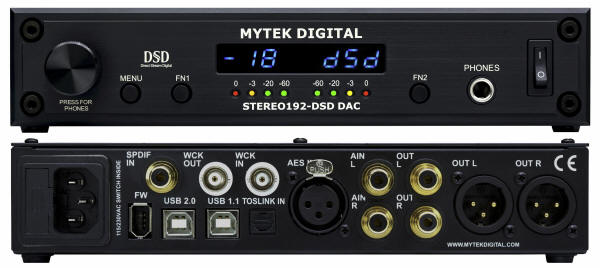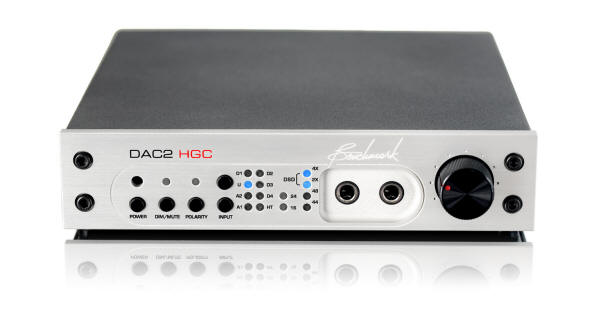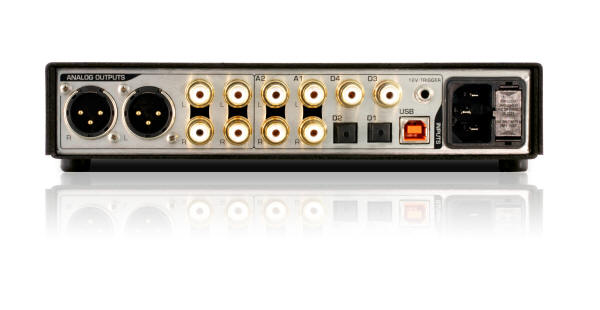|
You are reading the older HTML site
Positive Feedback ISSUE 64
Impressions: My Brutus Awards for 2012, Part
1
[All photographs and image processing by Robinson, unless otherwise noted. Drawings by Dan Zimmerman.] Every year creeps up on me, the stealthy beasts. It's nearly the end of 2012 already… and I was just getting warmed up. Psychological time is lapping me these days; every year is going by faster than the last. If you don't know what I mean, don't worry, that just means that you're a bit younger. Just wait a bit; you'll get it… because it gets you.
No matter; it's the Sunset Grill for 2012, and at the end of every year, I give my annual Brutus Awards. Like last year, this has been a very active and productive year here at PFO Central. I had a ton of reference-level gear arrive this year for evaluation, with some very exciting developments along the way. Great stuff, but a very heavy load! My comments from last year (see Issue PFO 58) now look prophetic: This has been an unusually rich year for some state-of-the-art audio designs in my listening room…in fact, a true embarrassment of riches for both digital and analog playback. It's also been a great year for desktop and computer-based systems. I've decided to break my PFO Brutus Awards for 2011 into two parts, both because there's so much to mention, and because it's a bit more logical that way. (2012, by the way, looks to be even heavier for new leading-edge audio designs… as I consider the logistics and the workload, I'm already feeling sorry for myself.) Yep! If you're new to PFO, you may want to know more about our Brutus Awards. They were set up back in 2003, when my unindicted co-conspirator Dave Clark and I decided that the time had come to add Positive Feedback Online's voice to the world of audiophile awards. (Why not? There are so many voices… some who know something, and some who do not. You'll have to sort that out.) There are several categories here. The Brutus Award itself is given to hardware and recordings that have been in my listening room for evaluation… not at shows, not at audio events, not at a friend's place… but right here, in a place of known quality. We also have the Lifetime Achievement Award, given occasionally to people who have merited recognition for their work in fine audio over sustained and extended periods in their lives. As I noted last year, All products that are so recognized by PFO will be work that has been reviewed by us personally; no design will be recognized that we do not have experience with in our listening rooms. This means that you, our readers, may disagree with our selections, wondering why this or that component, recording or individual was not mentioned. Quite apart from differences in taste/opinion, the answer is simple: we won't be mentioning any design that we haven't spent time with in our own listening rooms. The idea is pretty simple: what are the really great components that I've heard in my listening room this year, whether I've completed the formal reviews yet or not? What are the great recordings and reissues? Who are the key people in fine audio? There's also the Gizmo Award, in honor of our old friend, now departed, Harvey "Gizmo" Rosenberg. This is given from time to time…not every year… when a demonstrated true audiomaniac comes along who has gone over and above the call in design, audio alchemisticism, and Gizmological Gonzo Gonciousness. Some years I have a person who comes to mind; sometimes none. I do this award to honor my long-time audiobud, Harvey "Gizmo" Rosenberg, gone but not forgotten at this end. I haven't given one of those in a while, since there aren't very many true audiomaniacs out there. In 2009, I added our Circuitous Maximus Award, for those systems that demonstrated superior levels of synergy in my listening room. I stated last year that the CM "…will only be given when I've encountered multi-component systems that exhibit the very highest level of reference-grade synergy. Since that happens only once in a while, some years may see no Circuitus Maximus awarded at all." I'm very pleased to say that we've had several exceptional systems in that category since 2009, and will have another brilliant system listed this year. That's the intro. Here are the awards. Hardware MBL Radialstrahler 101E Mk. II, 9011 monoblocks, 6010D preamp, 1621 Transport, and 1611 DAC
Well, chillens, it's impossible to argue with the latest iteration of the MBL reference line. I've been listening to it for months now, and have been extremely pleased with its splendid performance at all levels. The new Radialstrahler 101E Mk. II omnidirectional speakers, driven by MBL reference electronics (the 9011s at this impedance are putting out around 875 Watts per channel) and sources are incredibly detailed, holographic, fast as lightning, and highly transparent. Bass is deep, but controlled; mids are round and clear; high frequencies are well-extended. Cabled with the excellent Kubala-Sosna Elation! interconnects and power cables, the MBL system turns our room into something like a full-range holodeck, minus the graphics.
As always, the 6010D preamp provides great gain without pain, and is one of the three or four best preamps that I've heard in our listening room here. The 1621/1611 tandem is CD only at this time, though DSD support may be added in 2013. (MBL are highly experienced with SACD and DSD, and already use Delta Sigma processing, oversampling to Double DSD rates of 5.6mHz with Red Book CDs.) The Red Book playback using delta sigma is exceptional; anyone with a large CD collection will be bloody impressed, as I was. I hope that we see support for DSD via USB 2.0 in the 1611 DAC in 2013; if so, it will be scary good.
Every component in the MBL reference system is top-o'-the-heap; in fact, this system is so good that I've awarded it my Circuitous Maximus Award for 2012 later in this article. Stellar work at all levels, MBL! World-reference quality, and one of the three best systems ever in my listening room. (So pay attention!)
Playback Designs MPS-5/USB-X, latest firmware patch Anyone reading my reviews knows that the Playback Designs MPS-5 with the USB-X interface for DSD over USB 2.0 has been the reference standard here for SACD, DSD, and CD reproduction. 2012 saw no change in this evaluation; with the latest firmware update to the MPS-5 (fall of 2012), the MPS-5 continues to lead the pack. With the latest update, soundstaging has deepened, imaging is even more precise, and the rendition of detail and timbre is better than ever, with DSD and (especially) Double DSD, as well as SACDs. I have also noticed an even more definite roundness to specific instruments and vocals that is utterly enchanting to my ears on all three formats. This is also true of standard CDs, to the lesser extent that this limited format can produce such effects. For software on the DSD side of things, we've used the latest beta of the Emotion Media Server for much of the year, which was good, but has not yet been released by Pyramix to distribution to the general public. Finally, in the fall I switched to JRiver's Media Center 18, easily available at a reasonable price from JRiver's Website. Media Center 18 supports both DSD and Double DSD quite nicely with the Playback Designs DACs. (See our software section below for JRiver's award.) The combination of Media Center 18 in Windows 7 64-bit and the MPS-5/USB-X is superb, and the interface easy to use. Note that if you're a Mac user, you can go with Channel D's Pure Music for DSD file playback. What I've said before, I'll say again: The Playback Designs MPS-5 with USB-X is the reference standard for digital audio reproduction in our listening system. Now that DSD downloadable files are available, you've got another reason to go with Playback Designs… if you can afford it, do it! Simple as that…. Bel Canto DAC 3.5 VB Mk. II and Dedicated Power Supply (images courtesy of Bel Canto)
Bel Canto's latest iteration in their fine line of DAC preamps was extended in my experience when the DAC 3.5 VB Mk. II arrived this year, together with its dedicated VBS1 "virtual battery" power supply. The same form factor as others in the line, the 3.5 VB Mk. II features a lowered noise floor, beaucoup I/O (including ST glass, a good thing) and a claimed dynamic range of 126 dB. Jitter is a claimed ultra-low 2 picoseconds…nice! The remote control is a dandy, handling all I/O, volume, and muting, naturally…but the 3.5 also handle mono/stereo, and phase inversion at the DAC, which you do not always see. Better yet, the 3.5's remote has one of the best angles of incidence that I've seen…nearly 180 degrees. It's very responsive from all sorts of directions.
The sound of the DAC 2.5, which I had for quite a while, was very fine, and merited a Brutus Award at the time. But I have to tell you that the DAC 3.5 VB Mk. II… taking S/PDIF from the Oppo BDP-95 and the brand new BDP-105, feeding the Bel Canto REF 150, and in turn talking to my Nova Ovation monitors…is a definite step forward. This system is the same that the DAC 2.5 was in; the only change was the changeover to the 3.5, and the addition of the Oppo BDP-105 at the very end.
The dynamics are definitely better, the noise floor is down in the basement someplace, and the DAC has better detail and slam with PCM sources from 44.1 kHz/16-bit all the way out to 192 kHz/24-bit. Very clean; very musical… and all of this with a very compact profile, and green power rating, to boot. Demmed great stuff!
Now if we can just get DSD support into the Bel Canto DACs… a DAC 4 VB?!... all will be complete! I can hardly wait…. A Brutus Award to Bel Canto for the DAC 3.5 VB Mk. II, for sure. United Home Audio Phase9 Reel-to-Reel Tape Deck
Now here is a thing of beauty! Greg Beron's superb United Home Audio Phase9 RTR machine paid me a visit for several months in 2012. Here you see it outfitted with another 2012 Brutus Award winner, the Reel-Tronix take-up reel (to the left above). My earliest experience with audio was with RTR decks. In fact, my first stereo system was wrapped around my Sony TC-630, purchased as a junior in high school after working an evening job for nearly a year. I own two RTR decks now, and have two other loaners here at the moment…one a Mike Spitz ATR 102, while the other isn't. So I have a real fondness for open reel. This means that when Greg Beron was willing to send a review sample of his Phase9 machine, I immediately jumped on the opportunity. The Phase9 is based upon a radical re-working of the Tascam BR-20, a RTR machine with very good availability of parts…a major consideration with RTR decks… and with a number of proprietary (and expensive!) improvements or complete redesigns made to the underlying frame. Fiendish attention is paid to the quality of the parts used…especially capacitors…the circuitry and wiring, and the Unity9 preamp. This last has been advanced towards direct coupling by simplifying and purifying the circuitry of the preamp, allowing a more transparent transmission of the music on tape. Greg claims to have sunk a small fortune into product development and the testing of expensive components, which he has exhaustively tested by ear. He is circumspect about the parts used, but let's just say that with the Phase9, you ain't in Kansas (or Tascamland) anymore, Toto. (For a list of improvements in the Phase9, see the appropriate section.)
The Tape Project: Open reel tapes as masterpieces! [Image courtesy of The Tape Project] As a side note, you should be aware of the fact that the UHA Phase9 has fixed output…standardized at 250nW, the same as the Tape Project tapes. This is due to the fact that Greg believes that variable tape outputs introduce impurities into the signal, which he is determined to avoid. This means that if you purchase the Phase9, you'll have to be careful with some open reel sources, which may be producing tapes with hotter output. Make sure that you check with the source of your open reel tapes before you buy…or specify 250nW tapes when ordering.
Greg Beron with the prototype of his new Phase11 RTR at RMAF 2012 The sonic dividends are spectacular. I can cut to the chase right now and say that listening to the Phase9 was outstanding in every way. All tape functions worked smoothly, without a glitch. Using some sample tapes from The Tape Project (thanks Dan and Paul!), Yarlung Records (ditto Bob!), and Opus3 (you too, Jan-Eric!), I got a chance to hear 15ips half-track sound the way that it can and should. Excellent transparency, loads of detail, low noise floor, a tremendous sense of ease, dynamic punch when needed, and gobs of natural musicality. So… what's not to like? I really hated to pack this up and send it back to Greg… I grieved… but then again, he's already working on the Phase11 for early 2013! I expect to see it sometime next year for a follow-up evaluation. Exceptional stuff, and a 2012 Brutus Award winner, for sure. SonoruS ATR10 RTR deck
An embarrassment of riches! 2012 saw more than one RTR deck arrive for evaluation. My good audio friend Bob Attiyeh of Yarlung Records recommended that I should check out Arian Jansen's SonoruS ATR10 RTR machine, which I was glad to do. Arian was very accommodating when I approached him, and sent along a review sample for me to check out.
Arian Jansen with his SonoruS ATR10 at THE Show Newport Beach 2012 The SonoruS ATR10 is based on the Revox PR99, a goodly compact machine that I owned briefly back in the early ‘90s. But the compact form factor is about the only thing that my old ma-cheen has with what Arian has done in the SonoruS RTR. He has retained the Studer/Revox mechanical transport…solid work, that, and still available for parts and repairs… but the electronics have been completely replaced with Arian's new designs and the new parts thereof. According to SonoruS, "The electronics of the ATR10, including the tape drive, the power supplies and the audio playback amplifiers are totally new designs using new parts that are currently in production." (See SonoruS for more information) This includes a modern tubed output stage that is ingeniously placed to allow convection to flow naturally up and through the ATR10's inner chassis space. Tube biasing is handled automatically by the ATR10, a pleasant touch. Both 7.5 ips and 15 ips are supported, half-track only, and both IEC and NAB equalization are easily switchable. Very handy! The clear priority with the ATR10 is to provide a RTR machine with a very simple-to-use design. There aren't a ton of controls, or a complicated tape-threading path. It has a compact form factor, a very clean and direct tape path, is not too heavy (41 pounds), and thus is capable of being handled by a single person, even if somewhat older… you know, like very many audiophiles! SonoruS touts the "plug and play" nature of their RTR deck, making it easy to setup in a typical audiophile system. It even features a wireless remote control! This was a first for me… I've never seen an open reel machine with wireless remote. Clearly, the ATR10 is built for ease of use, and simplicity of operation. You don't even have to be running back and forth to start/stop the music; just use the remote. One other function on the ATR10 that I appreciated quite a lot was the Library Tape winding option. This is a tape advance/rewind that isn't full speed. It allows you to advance the tape at proper tension for storage, without the risks and inconsistencies that a fast-rewind or fast-forward operation introduces for tape storage. This is a very thoughtful touch for those of us who want to store tapes correctly. The operation of the ATR10 was very clean and reliable. Given the simple tape path, threading tapes was no problem at all. You can hardly have difficulties here—unless you are still getting used to opposable thumbs.
The tape cover of Yarlung Records' Dialoghi, a splendid recording by Elinor Frey and David Fung…spectacular on the SonoruS ATR10! [Image courtesy of Yarlung Records] The sound of the ATR10, using the same tape sources as the UHA Phase9 (e.g., the Tape Project, Yarlung Records) was very fine. The overall tonal presentation struck me as rather smoother and perhaps a shade less detailed than the Phase9, but the ATR10 presented music from open reel in a very seductive way… it sucked you right in! It was outstanding to hear reference tapes sound so great in our listening room, without any complexities at all. Plug and play, for sure. In particular, the Yarlung tapes sounded as though they had come home… which they had. Bob Attiyeh and Yarlung had used the SonoruS to record the batch of four tapes that SonoruS sponsored (see more at Yarlung Records, including how to purchase these analog open-reel tapes). I can heartily recommend all four… see below for Yarlung's 2012 Brutus Award for music! The quality of the workmanship and playback with the SonoruS ATR10 was exemplary. Combined with its ease of setup and use, you really do have a compact world-class solution for the audiophile who's looking for a less daunting RTR machine for those half-track tapes that are now available from various sources (e.g., The Tape Project, Opus3, Yarlung Records). Brilliant work, and an obvious candidate for a 2012 Brutus Award… done!
There's that "embarrassment of riches": The SonoruS ATR10 (to the left) and the United Home Audio Phase9 in the same space-time continuum… Reel-Tronix
Not just eye candy! The superbly engineered Reel-Tronix take-up reel… Another Brutus Award winner this year is in a key support role for RTR machines: the take-up reel. Anyone who has spent a lot of time with open reel machines knows that a warped, bent, or otherwise out-of-true take-up reel is a serious pain in the ass. The sound of good tape scraping on a take-up has always driven me nuts. Not only is it a distraction in the playback… it shoots the heck out of a quiet room… but it's a sign that damage and deformation is happening, and that your RTR machine is having to fight wow and flutter. And it's probably losing. Who needs to spend thousands for a quality open reel machine, and hundreds of dollars per tape, only to have a warped take-up reel screw things up?
The good news is that you don't have to. Through Greg Beron of United Home Audio, I learned of Patrick Sinegal and Reel-Tronix. They produce big-time beautiful precision take-up reels via first-rate CMC processes. Patrick sent me a sample of their work; you see it in the two photographs above. Naturally the Reel-Tronix reel is a knock-out to look at… it really puts the Boop in Betty!...but the really good news is that it noticeably improved the quality of the playback. The tape feed became absolutely quiet and smooth. The linearity of transport led to a rock-steady transmission of notes and tones, and seemed to improve imaging, which became less unfocused. Naturally, scrape-free transport also meant that my precious tapes were not being periodically scalped at the edge, and my blood pressure stayed where it should be while listening. Patrick's reels are the best that I've ever seen by parsecs…this is fine, precision work. Note that PFO's Myles Astor, another big fan of open reel tape, gave the Reel-Tronix reels a big thumbs-up back in PFO Issue 62; check out it for his comments. What's to say? An obvious 2012 Brutus Award winner for tape accessories! If you have a RTR machine, don't even think about it. Get in touch with Patrick and Reel-Tronix, and order a batch for yourself ASAP. Oppo Digital BDP-105 universal player
The Oppo Digital BDP-105 audio-optimized universal player [All Oppo images courtesy of Oppo Digital] Late entries for consideration for a Brutus Award this year came in from the good folks at Oppo Digital. They've been wowing me for years now, winning awards from me (and others!) for the price-performance killer universal player products that they've been putting out for years now.
This year was no exception, as Oppo updated its product line again. Replacing the already very fine BDP-95 is the new BDP-105. It has some new features over the 95, including a significantly upgraded power supply (now torroidal), the latest ESS Sabre32 chipset, a headphone amp and ¼" jack up front, and support for just about every audio format out there. (See http://www.oppodigital.com/blu-ray-bdp-105/ for a detailed list of capabilities.) The chassis is noticeably taller (nearly 1") and heavier.
Of particular interest to me is the fact that Oppo BDP-105 now supports USB 2.0 asynchronous mode with its DAC. I've inquired about the BDP-105 supporting DSD over USB 2.0, and Oppo informs me that this is in the works, and will be implemented in a firmware update in the near future. If so, then the BDP-105 will become an excellent platform for just about any optical or computer-based file format that an audiophile might be looking for… and at an MSRP of $1199, a mild price increase from the BDP-95's $999. In ‘phile terms, this price is extraordinary. Additionally, the support for Blu Ray 4K, 3D, Internet-based apps like Pandora, VUDU, Netflix, and YouTube, its bevy of I/O options, including two HDMI 1.4a ports, and three USB ports, plus MHL for mobile devices, make the BDP-105 extremely versatile. My initial take on the sound of the BDP-105 after about a month of very heavy use is that there is definitely an improvement in transparency on SACDs (a ton of the latest from Analogue Productions, Mobile Fidelity, and Universal Japan's SHM SACD reissues), and that there is a greater weight and authority to the music as compared to the BDP-95. This is a step forward from the BDP-95… and the 95, which I've been listening to constantly over the past year, was a great player. I've got to say it: The combination of improved sound quality and the array of features and I/O make the Oppo BDP-105 a no-brainer, once again. This is the Swiss army knife of digital… if you're looking for most bang-for-the-buck that you'll see this season, here it is. An a definite Brutus Award winner! Mytek Digital Stereo 192-DSD DAC
The Mytek Digital Stereo 192-DSD DAC… a mighty mite! [Image courtesy of Mytek Digital] Here's some great news: A DAC that not only does PCM up to 192 kHz/24-bit, but also handles DSD (64fs) and Double DSD (128fs) via USB 2.0 very nicely! The Mytek Stereo 192-DSD DAC provides a nice array of I/O options, including USB 2.0 and 1.1, Firewire, S/PDIF, AES/EBU, BNC, and analog inputs. On the output side, both XLR and RCA are provided. Up front, there is even a ¼" headphone jack with volume control for those who prefer to keep it to themselves. (For more specifications, visit Mytek's site.) The Mytek comes out of 20 years of experience in digital design, with a very significant element of professional digital work. The results in this case and at this price point (an outstanding MSRP of $1595) are quite impressive. With its ESS Sabre32 chipset, the Mytek provides a robust and dynamic sound. Its PCM performance is certainly quite clean and clear at every resolution that I tried it with, subject to the usual caveats about the limitations that I find in PCM sound. DSD and Double DSD .DFF and .DSF files via USB 2.0 were something else: this is the mountaintop, and what I concentrated on. Here, the Mytek shone. Pairing it up with JRiver's excellent Media Center 18 (ASIO drivers and DSD mode) and Chris Sommovigo's Black Cat Morpheus RCA interconnects on the output, and running that to the Bel Canto 3.5 VB Mk. II cables, the results were splendid… truly amazing at this price point. This is how things should sound when you're listening to the finest format that I know: clean, clear, dynamic, never razor-edged, always musical. If anything, the Mytek may have the slightest touch of warmth, which I found quite alluring. Having spent hours listening to the Mytek with both DSD and Double DSD files from my HP Pavilion DV8 notebook (Intel i7 processor w/8 GB RAM and Windows 7 Ultimate 64-bit) in ASIO mode via JRiver's Media Center 18, I can say that the results were lovely, with nary a moment of audio digititis. What an accomplishment! DSD and Double DSD, 192 kHz/24-bit PCM stereo, and in a compact professional package. All in all, a bloody great price-performance from Mytek. Anyone on a budget who is looking for very fine DSD and Double DSD playback, and superior results with PCM, will find the Mytek Stereo 192-DSD a top-notch choice. A 2012 PFO Brutus Award winner, for sure! Benchmark DAC2 HGC
The Benchmark DAC2 HGC DSD-capable DAC [Images courtesy of Benchmark] "The DSD movement is underway! All aboard!" Amen, bruddah! We are starting to see the DSD Express pick up steam as we roll out of the station! There are now several alternatives in the sub-$2000 range, two of which are mentioned in this year's Brutus Awards. The first was the Mytek; the second is from the highly respected firm Benchmark. I've been listening to Benchmark DACs for years now. I've always been pleased with their performance, as year after year they ratcheted up their products as the demands of digital-to-analog processing grew higher and higher. Last year's DAC1 was very special, and received a Brutus Award from me for its excellent performance in handling high-resolution PCM files. The only thing that I missed was an ability to handle DSD files (e.g., .DFF and .DSF) as well, since I knew that we were already heading in that direction in the world of highest quality audiophile sound reproduction. Too bad, I thought; Benchmark is really missing out here. I even contacted them and communicated with their lead engineer, but wasn't sure that I made any progress. Until now. Benchmark has released its DSD solution at last, which is great news for lovers of the format. Benchmark's DACs have set a standard for affordable excellence in converters, with crisp, clear, detailed sound and a neutral presentation. I've listened to their work over the past few years, and have noted the consistent quality of each iteration of Benchmark's designs, reflecting the professional audio foundation upon which they stand. The DAC2 HGC continues this happy tradition. It's the same form factor as prior Benchmark DACs… but the front faceplate has been redesigned significantly for the new control buttons and indicators that all of the supported formats require. Controls up front include power, dim/mute, polarity, and input selectors. There are two ¼" headphone jacks up front, just like the earlier DAC1 HDR… sociable, that…and a volume pot.
In the rear are balanced (x1) and unbalanced (x2) outputs; the input side sports two sets of analog RCAs, two S/PDIFs, two TOSLINKs, and a USB 2.0/1.1 port. The USB port runs in asynchronous mode for better transmission of high data rates, and Benchmark's Ultralock2 system minimizes jitter to vanishingly low levels. Note that DoP 1.0 for DSD is detected on all digital ports, and processing shifts to native DSD at that point…very smart. (For a complete product profile, check out the Benchmark site. The DAC2 HGC will handle PCM out to 192 kHz/24-bit via S/PDIF or USB 2.0, and 64fs DSD (2.8224 mHz) files on USB 2.0. With PCs, you load the driver files for high-resolution playback (DSD, and anything above 96/24 in PCM), bring up the unit in Windows 7 in the usual way, fire up and configure your media server, and away you go. With the Benchmark, Media Center 18 is in DoP WASAPI Event mode, with bitstreaming set to DSD over PCM (DoP 1.0)…works very nicely, but is a very different configuration from the Mytek. Once loaded, the DAC2 HGC switches modes smoothly and automatically from DSD to PCM, and to various PCM resolutions. It's very pleasant to use. The handy Benchmark remote makes volume and input control very easy. The sound is extremely transparent, and very articulate…the ultra-low jitter rate is reflected nicely in the very fine clarity of the music. There is an ease an naturalness with the Benchmark that lets me relax into the music. In fact, I am listening to a wonderful Channel Classics DSD recording right now via the DAC2 HGC: Dejan Lazic doing some very fine Ravel (Ravel: Retrospection, Channel Classics 17502; the DSD download is available for purchase, just right for a melancholy Oregon afternoon in December. This is the way that a desktop system should sound! Everything from the quietest passages to the heavily dynamic sounds right, without any sign of the Benchmark DAC2 HGC sounding congested, overloaded, or lacking resolution. Superb. PCM playback of high resolution files was likewise very tactile and pleasing, though without the degree of naturalness and analog-like ease of DSD files. There is certainly no problem with PCM playback via the Benchmark, and the high resolution files that I tossed at it from HDTracks and companies like MA Recordings all sounded very good, indeed. At $1,995.00, this is another reasonably-priced DSD and 192/24 PCM solution for audiophiles. Kudos to Benchmark for such a breakthrough in price-performance, and for incorporating native DSD conversion into this beautiful DAC. Definitely a Brutus Award winner for 2012… done! [End of part 1…]
|

